Zoom
Trash

Amalthea (mythology) Amalthea's skin, or that of her goat, killed and skinned by the grown Zeus, became the protective Aegis in some traditions, a vivid enough metaphor for the transfer of power to this Olympian god from that of the goddess who preceded his cult.
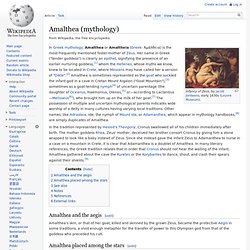
Parmeniscus says that a certain Melisseus was king in Crete, and to his daughters Jove was brought to nurse. Since they did not have milk, they furnished him a she-goat, Amalthea by name, who is said to have reared him. She often bore twin kids, and at the very time that Jove was brought to her to nurse, had borne a pair. Aries (astrology) Aries (♈) /ˈɛəriːz/ (meaning "ram") is the first astrological sign in the Zodiac, spanning the first 30 degrees of celestial longitude (0°≤ λ <30º).
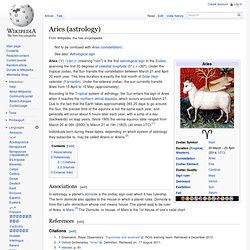
Under the tropical zodiac, the Sun transits this constellation between March 21 and April 20 each year. This time duration is exactly the first month of Solar Hejri calendar (Farvardin). Capricornus. (Unicode ♑).
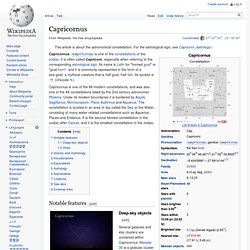
Notable features[edit] The constellation Capricornus as it can be seen with the naked eye.[2] Deep-sky objects[edit] Several galaxies and star clusters are contained within Capricornus. Messier 30 is a globular cluster located 1 degree south of the galaxy group NGC 7103. M30 (NGC 7099) is a centrally-condensed globular cluster of magnitude 7.5. One galaxy group located in Capricornus is HCG 87, a group of at least three galaxies located 400 million light-years from Earth (redshift 0.0296). Stars[edit] Capricorn is a faint constellation, with only one star above magnitude 3; its alpha star has a magnitude of only 3.6.
Chimera (mythology) The term chimera has come to describe any mythical or fictional animal with parts taken from various animals, or to describe anything composed of very disparate parts, or perceived as wildly imaginative or implausible.
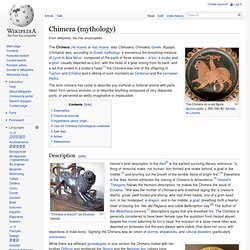
While there are different genealogies, in one version the Chimera mated with her brother Orthrus and mothered the Sphinx and the Nemean lion (others have Orthrus and their mother, Echidna, mating; most attribute all to Typhon and Echidna). The Chimera finally was defeated by Bellerophon, with the help of Pegasus, at the command of King Iobates of Lycia. Since Pegasus could fly, Bellerophon shot the Chimera from the air, safe from her heads and breath.[8] A scholiast to Homer adds that he finished her off by equipping his spear with a lump of lead that melted when exposed to the Chimera's fiery breath and consequently killed her, an image drawn from metalworking.[9]
Faun. Origins[edit] The faun is a half human–half goat (from the head to the waist being human, but with the addition of goat horns) manifestation of forest and animal spirits that would help or hinder humans at whim.
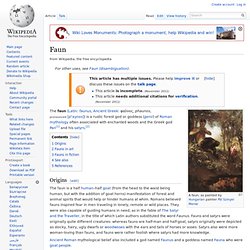
Romans believed fauns inspired fear in men traveling in lonely, remote or wild places. Goldhorn. "Zlatorog" redirects here.
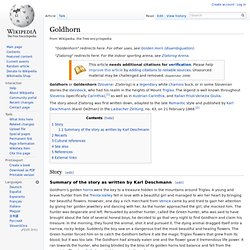
For the indoor sporting arena, see Zlatorog Arena. The story about Zlatorog was first written down, adapted to the late Romantic style and published by Karl Deschmann (Karel Dežman) in the Laibacher Zeitung, no. 43, on 21 February 1868.[2] Story[edit] Summary of the story as written by Karl Deschmann[edit] Recasts[edit] The story of Goldhorn was put into verses by Rudolf Baumbach and published in 1877, becoming his most popular work.[3] It was turned into an opera by Camilla and Eduard Lucerna. Heiðrún. The goat Heiðrún consumes the foliage of the tree Læraðr, while her udders produce mead, collected in a pot below (1895) by Lorenz Frølich.
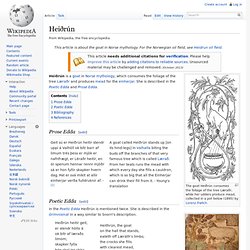
Heiðrún consumes the leaves of Læraðr atop Valhalla in an illustration from an 18th-century Icelandic manuscript. Heiðrún is a goat in Norse mythology, which consumes the foliage of the tree Læraðr and produces mead for the einherjar. She is described in the Poetic Edda and Prose Edda. Prose Edda[edit] Poetic Edda[edit] In the Poetic Edda Heiðrún is mentioned twice. Since Snorri quotes other strophes of Grímnismál it seems reasonable to assume that he knew this strophe too and used it as his source for his description of Heiðrún.
Khnum. Khnum (/kəˈnuːm/; also spelled Khnemu) was one of the earliest Egyptian deities, originally the god of the source of the Nile River.
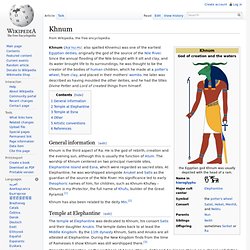
Since the annual flooding of the Nile brought with it silt and clay, and its water brought life to its surroundings, he was thought to be the creator of the bodies of human children, which he made at a potter's wheel, from clay, and placed in their mothers' wombs. He later was described as having moulded the other deities, and he had the titles Divine Potter and Lord of created things from himself.
General information[edit] Temple at Elephantine[edit] The temple at Elephantine was dedicated to Khnum, his consort Satis and their daughter Anukis. Satyr. The satyrs' chief was Silenus, a minor deity associated (like Hermes and Priapus) with fertility.
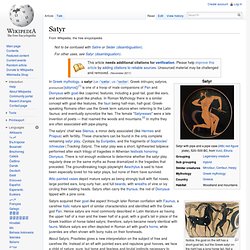
These characters can be found in the only complete remaining satyr play, Cyclops, by Euripides, and the fragments of Sophocles' Ichneutae (Tracking Satyrs). The satyr play was a short, lighthearted tailpiece performed after each trilogy of tragedies in Athenian festivals honoring Dionysus. There is not enough evidence to determine whether the satyr play regularly drew on the same myths as those dramatized in the tragedies that preceded. The groundbreaking tragic playwright Aeschylus is said to have been especially loved for his satyr plays, but none of them have survived. Attic painted vases depict mature satyrs as being strongly built with flat noses, large pointed ears, long curly hair, and full beards, with wreaths of vine or ivy circling their balding heads. Sidehill gouger. The Sidehill Gouger: a "left-sided" mother looks forlornly at her "right-sided" pup.
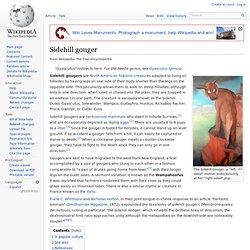
Sidehill gougers are North American folkloric creatures adapted to living on hillsides by having legs on one side of their body shorter than the legs on the opposite side. This peculiarity allows them to walk on steep hillsides, although only in one direction; when lured or chased into the plain, they are trapped in an endless circular path.
The creature is variously known as the Sidehill Ousel, Gyascutus, Sidewinder, Wampus, Gudaphro, Hunkus, Rickaboo Racker, Prock, Gwinter, or Cutter Cuss. Gougers are said to have migrated to the west from New England, a feat accomplished by a pair of gougers who clung to each other in a fashion comparable to "a pair of drunks going home from town"[3] with their longer legs on the outer sides. A Vermont variation is known as the Wampahoofus. Frank C. In popular culture[edit] See also[edit] References[edit] Jump up ^ Brown, C.E. Dill, Lawrence M. (1983). Tanngrisnir and Tanngnjóstr. The goats Tanngrisnir and Tanngnjóstr pull the god Thor's chariot in an illustration from 1832.
Tanngrisnir (Old Norse "teeth-barer, snarler") and Tanngnjóstr (Old Norse "teeth grinder") are the goats who pull the god Thor's chariot in Norse mythology.